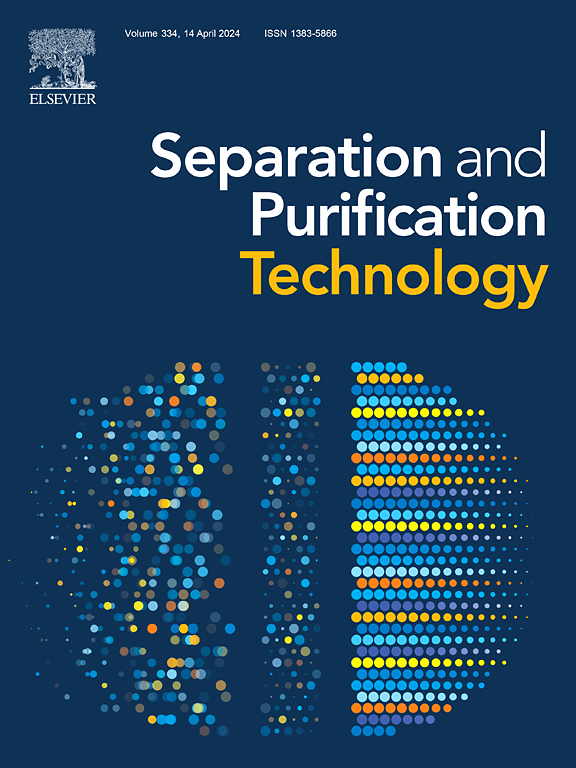膜级联在环境水中基于尺寸的纳米塑料分离和浓缩
IF 8.1
1区 工程技术
Q1 ENGINEERING, CHEMICAL
引用次数: 0
摘要
纳米塑料(NP)在淡水和海水中的存在是一个日益严重的环境问题,尽管人们对它们的数量、结构或与天然有机物(NOM)相关的行为知之甚少。虽然已经努力隔离它们,但以前的方案无法最大限度地减少提取过程中的损失,从而无法可靠地表征。此外,NP大小的分离,对于理解它们的运输动力学和毒性至关重要,仍然具有挑战性。本研究提出了一种使用微滤(MF)膜级联的新方案,以i)从天然水中提取NP, ii)按大小范围分离它们,iii)浓缩每个部分,iv)最大化回收率。采用不同尺寸的荧光聚苯乙烯纳米塑料(PS NPs)进行了过滤实验,以说明环境NP的尺寸多分散性并评估膜选择性。结合综合膜表征和污染模型,结果表明,级联2 µm的不锈钢网格,0.45 µm的PVDF膜和0.1 µm的PES膜成功地将NP分离成三个尺寸范围(<; 50 nm;50 - 500 海里;500 nm PS NPs的可重复回收率为52. %,200 nm PS NPs的可重复回收率为95 %,50 nm PS NPs的可重复回收率为93 %。在掺入PS NPs的真实河水中测试了该级联反应:当NOM浓度为0.11-0.54 mg/L时,各粒径组分的选择性和回收率都保持不变。该过滤级联的发展将为高效提取环境NP奠定基础,并揭示了MF膜在这一前景中的应用的新知识。本文章由计算机程序翻译,如有差异,请以英文原文为准。

A membrane cascade for size-based separation and concentration of nanoplastics in environmental waters
The presence of nanoplastics (NP) in freshwater and seawater is a growing environmental concern, although little is known about their amount, structure or behaviour associated with natural organic matter (NOM). While efforts have been made to isolate them, previous protocols were not able to minimize losses during extraction, preventing reliable characterization. Additionally, NP size fractionation, crucial for understanding of their transport dynamics and toxicity, remains challenging. This study presents a new protocol using a cascade of microfiltration (MF) membranes to i) extract NP from natural waters, ii) separate them by size range, iii) concentrate each fraction, iv) maximize recovery rates. Filtration experiments were performed using fluorescent polystyrene nanoplastics (PS NPs) of various sizes to account for the size polydispersity of environmental NP and evaluate membrane selectivity. Coupled with comprehensive membrane characterization and fouling models, the results showed that cascading a 2 µm stainless steel grid, a 0.45 µm PVDF membrane and a 0.1 µm PES membrane successfully allowed to separate NP into three size ranges (< 50 nm; 50–500 nm; 50–2000 nm), while achieving repeatable recoveries of 52 % for 500 nm PS NPs, 95 % for 200 nm PS NPs and 93 % for 50 nm PS NPs. The cascade was also tested on real river water doped with PS NPs: selectivity and recovery of all size fractions could be maintained for NOM concentrations of 0.11–0.54 mg/L. The development of this filtration cascade will serve as a foundation for efficient extraction of environmental NP, and unveils new knowledge about the use of MF membranes in this prospect.
求助全文
通过发布文献求助,成功后即可免费获取论文全文。
去求助
来源期刊

Separation and Purification Technology
工程技术-工程:化工
CiteScore
14.00
自引率
12.80%
发文量
2347
审稿时长
43 days
期刊介绍:
Separation and Purification Technology is a premier journal committed to sharing innovative methods for separation and purification in chemical and environmental engineering, encompassing both homogeneous solutions and heterogeneous mixtures. Our scope includes the separation and/or purification of liquids, vapors, and gases, as well as carbon capture and separation techniques. However, it's important to note that methods solely intended for analytical purposes are not within the scope of the journal. Additionally, disciplines such as soil science, polymer science, and metallurgy fall outside the purview of Separation and Purification Technology. Join us in advancing the field of separation and purification methods for sustainable solutions in chemical and environmental engineering.
 求助内容:
求助内容: 应助结果提醒方式:
应助结果提醒方式:


